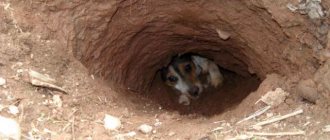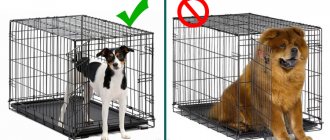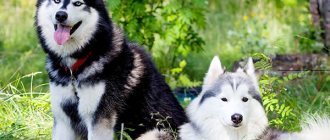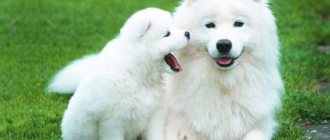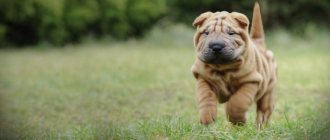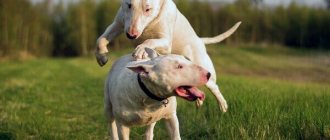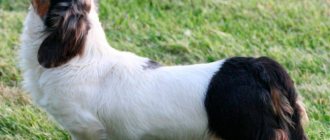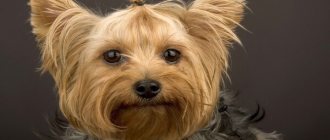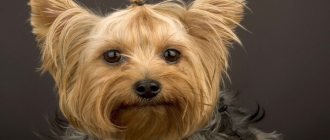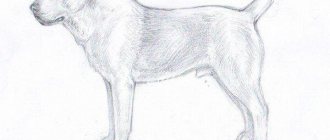Labradors are considered one of the most popular dog breeds these days.
Because of their friendly nature and easy-going nature, they have become family members and best friends for many.
These dogs fit perfectly into people's lives and filled it with emotions and new impressions.
After all, Labradors can add variety to even the most boring life.
What is the breed standard
A dog breed standard, including a Labrador, is a set of characteristics and physical attitudes for an animal that must be preserved for the purity of the breed and the health of the breed.
The standard was approved in 1987 for two varieties of breeds - American and English Labrador . The standard includes not only the exterior, but also the characteristics of the dog’s temperament.
In dog breeding, it is customary to focus on the English standard of the Labrador breed, because it was adopted somewhat earlier than the American one.
The American breed standard is not much different from the English, this mainly concerns the temperament of dogs - “Americans” are more active than “English”.
Deviation from standard
Breeders advise against breeding dogs that do not meet the standard, so they are usually spayed or neutered. Puppies that do not meet the breed standard are spotted puppies and dudley puppies. Dudleys are retrievers with abnormal pigmentation.
They have a pink or coffee-colored tip of the nose, while the nose itself is also light brown. Their eyelids and gums are light, while the standard is dark. The main color is any – both black and golden.
Important! If you are getting a puppy for yourself, without showing it in competitions, then you can safely take such a baby, since a pink nose does not affect the dog’s health.
There are cases when black babies have white hairs. Later, recoloring occurs, the dog becomes charcoal in color, but is not suitable for breeding.
Cubs with white “socks” and spotted dogs also do not fall under the standard, which does not prevent them from remaining loyal and intelligent dogs. And you can buy such a puppy much cheaper
Unusual color at birth
Several cases have been recorded in the world and one of them was in England, a green Labrador was born. The newborn puppies of a pair of fawn retrievers had a greenish tint to their fur .
When studying this amazing fact, it turned out that a dog’s placenta contains a substance called biliverdin, which gives this color. But as it grows, the green color goes away and the puppy becomes creamy, just like its parents.
What does a dog look like according to the RKF?
- Torso . The Labrador's back line should be straight, the croup should be short and strong. There should be no hunchbacks. Labradors have a wide chest, barrel-shaped ribs, well-defined withers, and a medium-length tail, wide at the base and tapering towards the end. It’s hard to imagine Labradors without such an otter-like tail. It should be located horizontally to the lower back. In the active state, it can be slightly raised, but a crescent shape or bend behind the back is not allowed.
- Head and muzzle . Labradors have a large and massive skull, which stands out a little from the whole image. The cheeks are dry, not fleshy. The muzzle is slightly wide, not too long. Narrow or short is not allowed. The nose is large, with wide nostrils. Labradors' ears are in a hanging position and slightly behind the head. Should not be too long or heavy. The eyes have a friendly and intelligent appearance; only dark shades and medium-sized irises are allowed. The bite is scissor-shaped and the upper jaw completely covers the lower jaw. The neck is dry, long and without folds.
- Fore and hind limbs . The general appearance of the limbs is strong and muscular, located parallel to each other. The length of the forelimbs is equal to half the length of the animal at the withers. The pasterns are in the same plane as the forearm, the hock joints are clearly visible.
- Wool. Labradors have short hair, often short. It is hard to the touch, with a dense and dense undercoat underneath. The main feature is water resistance.
Expert opinion
Kozhevin Semyon Kirillovich
Expert dog handler.
“I think the main feature is the tail. This is what they look at, this is due to its specific shape. Another distinctive feature is the ears. They are located as if behind the head. It is also easy to check how purebred a Labrador is by looking at its undercoat. It is especially thick in this breed and also performs water-repellent functions. Well, basically Labradors look like strong and muscular dogs, their movements are smooth, cutting through the air.”
Anatomical structure of Labrador
1. Skull 2. Occiput 3. Cervical vertebrae (7) 4. Thoracic vertebrae (13) 5. Lumbar vertebrae (7) 6. Sacral bone 7. Pelvis 8. Caudal vertebrae 9. Femur 10. Tibia 11. Tarsal bone 12. Metatarsal bone 13. Fibula
4. Patella 15. Ribs 16. Sternum 17. Metacarpal bones 18. Phalanges 19. Carpal bones 20. Ulna 21. Radius 22. Humerus 23. Substernum 24. Scapula 25. Lower jaw
Shade and color
Three shades of color are allowed for Labrador Retrievers:
- Solid black;
- Pale yellow;
- Chocolate (brown or liver).
Fawn can range from light cream and golden to fox red. It is acceptable for them to have a small white spot on their chest.
Solid color means that the coat should not contain any other color or pigmentation. On the other hand, tan dogs may have a darker back than the rest of their body.
Black Labradors have a different undercoat color - it can be gray or reddish brown . This is due to the fact that any color can have its own shades.
For chocolate-colored Labradors, the tan that sometimes appears on them cannot be considered a solid color.
A dog's color may also change before and after shedding, but not significantly..
The influence of color on character
Speaking about the character of Labradors, it is worth noting that coat color does not have any influence on it. Tar dogs or silver labs are no bolder than cream dogs, and red dogs, and cream dogs are no friendlier.
All dogs are excellent hunters and swimmers. They are all friendly and good-natured, easy to train and love to swim in puddles or mud. This can be a decisive factor when choosing the color of your future pet, since dirt is immediately visible on a beige dog and will have to be washed frequently.
Coat type
As already mentioned, this breed has short hair with a dense undercoat . It should be hard to the touch, dense and without bald spots. There should be no fringes or curls on it.
IMPORTANT!
The undercoat has water-repellent properties.
The undercoat is never the same color as the center coat . Its peculiarity is fat, which should be noticeable if you run your fingers over it.
Recommendations for education and training
Training dogs of this breed can begin at an early age, starting as early as four to five months. However, this recommendation is relative and aims at early adaptation of the puppy to the social external environment.
However, even at the age of over two years, these dogs learn commands well and quickly remember them. The docile and calm nature of the Labrador breed is fully demonstrated here in the description of the standards, but this should not be abused. They are quite trainable, but they may not remember some commands right away. In this case, you have to show persistence, which in no case should be brought to the point of rigidity.
When training, it is important to be able to show patience - it will be needed when learning complex commands or those that the dog does not like.
Puppies and older Labradors usually perceive such activities as a game and readily get used to them. In order for your pet to better and faster understand what is required of him, it is advisable to give him a treat during classes for a well-completed task. By the way, they are ready to carry out the orders of the owner even for a good word - dogs of this breed love praise. Especially if it is expressed with warmth and not formally. By the way, you cannot turn such training sessions into a monotonous, everyday activity - the dog will quickly get tired and not obey well.
Pet behavior
The Labrador Retriever's temperament has the following characteristics::
- This breed is distinguished by excessive intelligence and intelligence, which is what their look should indicate;
- They always try to be useful to a person, become attached, try to become a true friend for them;
- Get along equally well with adults and children;
- They have a high level of learning ability, because of this they are easy to train and amenable to education;
- They are friendly, kind and non-aggressive. Aggression is a disqualifying sign.
Predisposition of Labradors to diseases
In general, representatives of this breed are quite strong in terms of health and are not prone to numerous diseases. However, they also have weak points when the body can malfunction.
For example, puppies can develop obesity if the owner has relaxed control over feeding. In addition, they are characterized by a disease such as deafness.
Given the weight and height of adult dogs, it is not surprising that they may suffer from orthopedic conditions, the most common of which is hip dysplasia. However, this should not be considered a tendency to illness - such a pathology usually occurs only as a result of overfeeding.
Also one of the potential problems is eye diseases. Of these, the most common are retinal atrophy and cataracts. Slightly less common are cases of corneal dystrophy.
As for infectious diseases, diseases such as viral hepatitis, canine distemper, parvovirus enteritis, parainfluenza and viral hepatitis may pose a particular threat. However, these diseases are often reported in Labrador Retriever puppies under 2 years of age.
Among the invasive diseases that dogs are prone to are helminthic diseases such as ascariasis or toxocariasis.
Considering all of the above, the Labrador Retriever is one of the dogs with good health.
Can a dog change as it ages?
Like any other creature, your Labrador's behavior and appearance can change with age.
This is most evident in changes in character traits.
Aging Labradors now perceive separation differently; they become susceptible to separation from their owner and react to it especially acutely . When meeting, they can be violent, rejoicing at the return.
They also become less receptive to commands, and their activity decreases.
You can also notice changes in appearance - they look haggard, move slower than usual, the coat becomes more faded.
Features of feeding an adult Labrador
As an adult, a Labrador Retriever dog should be completely switched from dry food to food made from natural products, which, of course, is better for his health. This breed of animal is a hunting one, so the diet should be based on animal protein. In percentage terms, this looks like 50 to 60% meat or meat products to ensure the normal functioning of the dog for many years.
But this does not mean at all that you need to feed an adult Labrador only meat; it will be better if the rest is supplemented with porridge (about a third of the diet) and boiled vegetables. In addition, it would not be superfluous to include fish and fermented milk products in the diet of an adult dog, which will help keep the dog’s weight within the desired limit.
The dog's transition to natural food also includes the inclusion of special vitamins, which can be purchased in specialized pet stores.
An adult Labrador retriever should consume 500 grams per day. food in 2 doses, that is, 250 g. for each appointment. The main requirement of the feeding process for an adult Labrador is the exception of pampering your pet with smoked meats and sweets. And also the exclusion of feeding the dog with table scraps.
How to distinguish a Labrador puppy from a mixed breed
It will not be difficult for an experienced owner to distinguish a Labrador from a mongrel, but beginners in this area may have questions:
- Any manifestation of aggression, even in a puppy, should alert you: Labradors do not have this quality.
- Labrador puppies have a slightly larger head than the rest of their body. They are somewhat robust, with medium-sized eyes, and their noses are not elongated or pointed.
- The ears should be completely hanging and not too long. Located behind the head.
- Another distinctive feature is the tail, similar to that of an otter.
- Dense coat, thick undercoat. It should be somewhat harsh to the touch, even for puppies.
- The color is solid, without spots or pigmentation. Only a white spot on the chest is allowed.
Pay attention to the puppy's behavior.
He should be active, but at the same time listen to your words . The look is conscious, interested and friendly.
Genetics of the Labrador breed
The English Kennel Club in 1903 recognized only the black color of Labradors, whose history began in the 19th century.
In heredity, the shade of the coat plays a priority role, especially when breeding pedigree animals. A combination of genes responsible for this indicator has been identified. This necessitates a thorough study of the pedigree when purchasing puppies. However, experienced dog breeders are confident that this knowledge may not be enough.
The dominant genes are B and E, which give the coat a black tint. Recessive analogues (b and e) are responsible for chocolate and fawn (yellow) colors.
How to choose a thoroughbred?
- Buy a puppy not “from hand”, but from nurseries and boarding schools that specialize in breeding them;
- Check the puppy's pedigree through a special database. There you will see his parents too;
- The puppy's appearance should be well-groomed and well-fed. There should be no discharge from the eyes, mouth or ears, the stomach should be free of rashes and not swollen;
- Look at the parents and ask the breeder in more detail about them: where they were exhibited, what titles they have, if the conversation goes well, then you can even ask for the relevant documents confirming his words;
- Look at the puppy's documents. They should contain information about the registration, his parents, the brand number that matches the one on the puppy;
- Check with the vet. a passport where all vaccinations given to him should be recorded;
- Compare the puppy with the standard indicators.
NOTE!
If you want to purchase a real purebred Labrador, you will have to spend a long time studying all the documents that the breeder provides and be extremely attentive to the details and his words.
Features of keeping a Labrador Retriever
The main factor that can influence the determination of the conditions for keeping a Labrador Retriever is its character. Basically, these are dogs that are distinguished by their kindness and responsiveness, which get along with humans very quickly and easily. Due to the fact that such dogs are unpretentious to the environment that surrounds them, they can very quickly adapt to the created conditions, both in the stage of an adult animal and in the stage of a young puppy.
A Labrador Retriever dog can be kept both in a private house and in an apartment. In any case, such dogs will be characterized as:
- Sociable and kind.
- Smart and easy to train.
- Hardy.
- In good health.
Keeping a Labrador Retriever in a private house on the street or in an apartment has its own characteristics:
- The friendliness and cleanliness of a Labrador, no matter how old he is, allows him to be kept in an apartment, even despite the impressive size of the pet. A Labrador will always get along with children and other residents of an apartment for many years, even if it is small. An important aspect of a Labrador living in an apartment is the presence of a personal place to rest and a toilet. It is important to provide your pet with timely walks outside while living in an apartment. Such walks should be at least 2-3 hours throughout the day. At the same time, in the morning it is necessary to walk the dog for at least 1 hour, during the day 40 minutes will be enough, and in the evening the Labrador needs to walk for at least 1.5 hours. Thus, throughout the day, the Labrador will have the opportunity to throw out all the accumulated energy and get the physical activity necessary for health.
- Owners of a private home can keep a Labrador retriever in a specially equipped enclosure. When cold weather sets in, the dog can stay in a specially designed booth installed on the territory of the enclosure. It is a mistake to believe that during the cold season a pet of this breed needs to be allowed into the house; a Labrador can “winter” in a kennel for many years without harm to its health. But, given the sociability and friendliness of the Labrador, the owner is obliged to provide the dog with constant communication with himself and other family members, in order to avoid the manifestations of diseases against the background of a psychological disorder.
